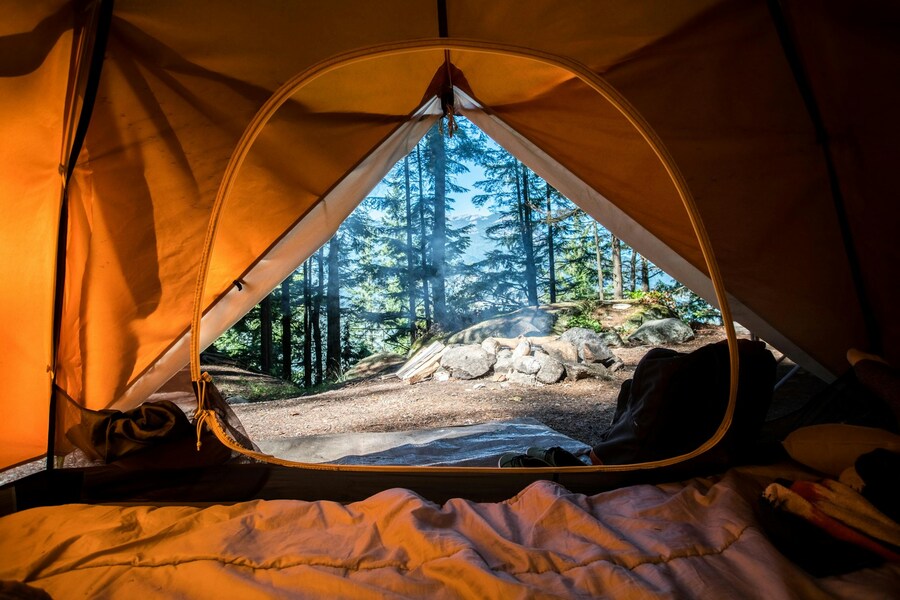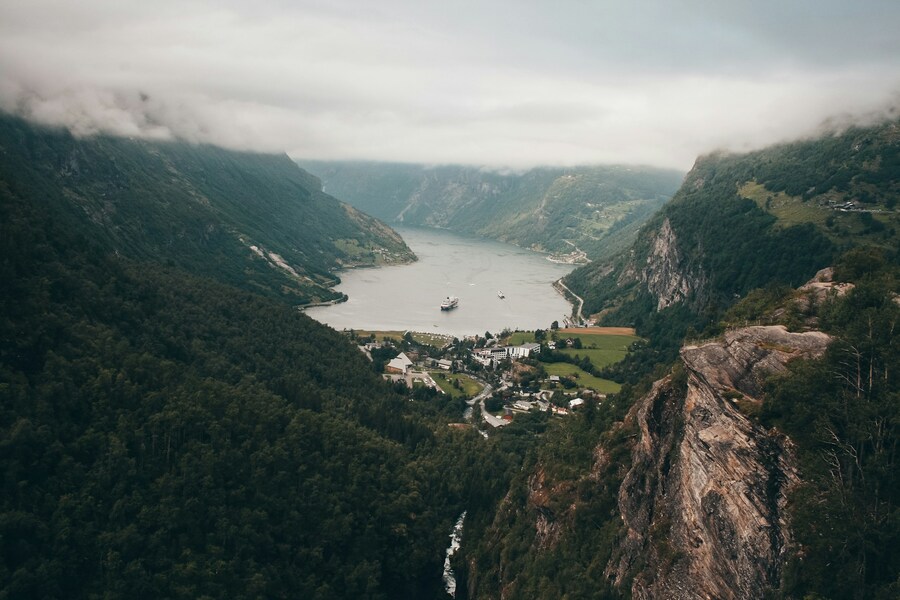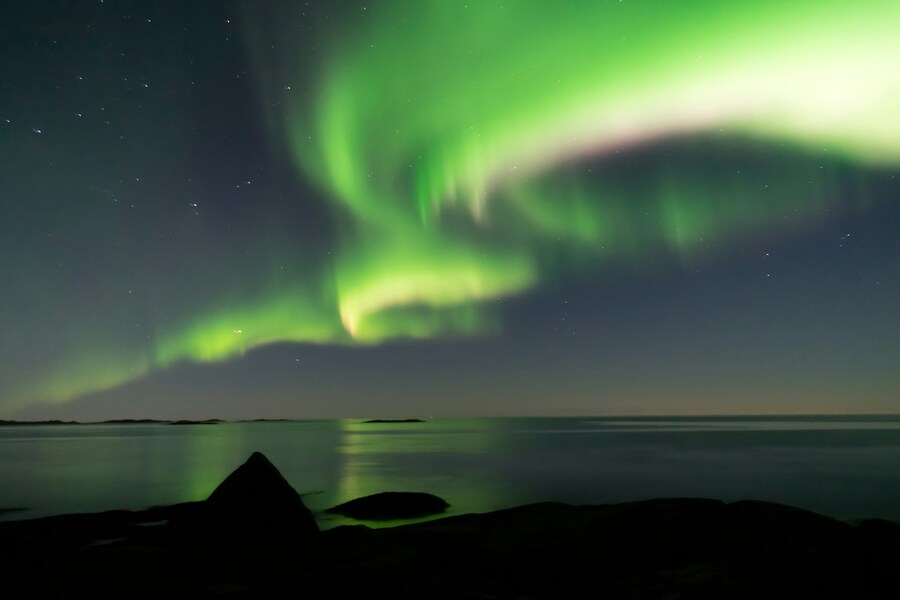Norway is a spectacular land of breathtaking extremes, from the cobalt fjords and sheer cliffs to the ethereal aurora borealis. It's a nation where ancient Viking history meets modern urbanity. This travel guide is your essential compass for navigating Norway's dramatic landscapes and rich cultural tapestry, ensuring a meticulously planned Nordic adventure. So, let's dive in!
Table of contents
- Getting here
- Things to do
- Places to go
- Getting around
- Seasons and climate
- Outdoor activities
- Plan your trip
What are the key arrival hubs and essential pre-trip planning steps for getting to Norway?

Source: Scott Goodwill/Unsplash
Getting here
Norway is exceptionally well-integrated into the global travel network, making arrival straightforward regardless of your starting point. The vast majority of international visitors arrive by air, primarily landing at Oslo Airport (OSL), which serves as the country's main international hub. Other crucial gateways include Bergen Airport (BGO), essential for those heading directly to the Western Fjords, and Trondheim Airport (TRD), which facilitates access to Central Norway and points further north. Many major European and intercontinental airlines operate frequent services to these cities. For travelers coming from nearby European countries, a scenic alternative is arrival by ferry, with routes connecting coastal cities like Oslo and Bergen to ports in Denmark and Germany, offering a tranquil introduction to the maritime landscape.
When planning the initial stages of your journey, managing airport logistics is key to a stress-free start. For travelers driving to their departure airport, securing reliable, pre-booked long-term parking is a highly recommended practice. A resourceful platform like ParkingNearAirports.io specializes in connecting travelers with the best airport parking deals, providing crucial convenience from the moment you leave your car. They offer essential services, including options for secure, efficient airport shuttle parking, which transports you directly to your terminal without delay. By taking advantage of their online booking platform, you can secure a substantial airport discount on the standard daily parking rates, transforming a potential logistical headache into a smooth, cost-effective transition into your vacation. This attention to detail in the earliest planning phase sets a positive tone for the entire trip. It's always wise to book all flights and ground transportation well in advance, especially during the peak summer months, as Norwegian travel infrastructure experiences high demand during warmer periods.
Things to do
The activities available in Norway are as varied as its geography, appealing to history enthusiasts, cultural connoisseurs, and adrenaline seekers alike. Begin your urban exploration in Oslo, where the city's contemporary architecture often stands in striking contrast to its ancient roots. The Viking Ship Museum, which houses some of the best-preserved Viking vessels from the 9th century, is an absolute must-see, offering a powerful glimpse into the seafaring heritage that shaped the country. In stark contrast, the vibrant modernism of the Oslo Opera House, which allows visitors to walk on its slanted roof, offers a perspective on Norway's commitment to contemporary design and public art.
Culinary exploration is also a primary activity. Norway is famed for its fresh, high-quality seafood, including its world-renowned salmon and cod. In Bergen, you can sample the day's catch at the historic Fish Market. Beyond the ocean's bounty, seek out traditional Norwegian fare, such as fårikål (mutton and cabbage stew) or the regional specialty raspeballer (potato dumplings), often found in cozy, family-run establishments. One of the most uniquely Norwegian activities is taking a scenic rail journey. The Oslo-Bergen railway is often cited as one of the most beautiful train rides in the world, traversing mountain plateaus and passing through high-altitude stations. Even more famous is the Flåm Railway, a stunning 20-kilometer descent from the mountain station of Myrdal down to the picturesque village of Flåm, located deep within the Aurlandsfjord. This journey, passing roaring waterfalls, is a mandatory experience for photographers. For a historical and religious cultural immersion, seek out Norway's remaining stave churches, particularly the UNESCO-listed Urnes Stave Church, one of the oldest and most architecturally significant wooden structures in the world.
Places to go
Norway's immense size and diverse regional identities mean that selecting a few key destinations is essential for focused travel. The absolute cornerstone of any Norwegian journey is the Western Fjords. Specifically, the Geirangerfjord and the Nærøyfjord, both inscribed on the UNESCO World Heritage List, represent the pinnacle of fjord scenery. These narrow, deep-cut waterways are flanked by towering cliffs, with abandoned farms clinging improbably to the ledges and ribbon waterfalls cascading hundreds of meters into the sea. Bergen, the second-largest city, acts as the perfect gateway to this region. Its historic Bryggen wharf, a line of brightly painted, iconic wooden Hanseatic commercial buildings, is a UNESCO site and a captivating place to wander, embodying centuries of trade history along the quay.
Getting around

Source: Bea Fladstad/Unsplash
Navigating Norway's challenging terrain – a mix of mountains, fjords, and vast areas – requires smart travel choices based on itinerary and budget. Domestic flights offer the fastest way to cover long distances, particularly to the Arctic, though they are the most expensive. Trains, operated by Vy, provide comfortable, scenic, and highly recommended transport between major southern cities (like the famous Bergen Line), but the rail network is geographically limited. For ultimate flexibility and access to remote trailheads, driving is the preferred option; however, be prepared for high fuel costs, city congestion charges, tolls for tunnels, and the necessity of frequent car ferries for fjord crossings. Alternatively, a comprehensive bus network is cost-effective and serves many areas inaccessible by train. For a unique, coast-to-coast experience, the Coastal Express (Hurtigruten) is indispensable, functioning as a vital transport link sailing the entire length of the coast from Bergen to Kirkenes, allowing travelers to witness the country's magnificent fjords from the sea.
Seasons and climate
Understanding Norway's distinct seasons is paramount to planning your trip, as the climate dictates the availability of specific activities and dramatically alters the landscape. The country stretches far above the Arctic Circle, resulting in vast differences in daylight and temperature between the south and the far north, and between seasons. Summer (June to August) is the peak travel season. Temperatures are mild, especially in the south, where they can occasionally reach the mid-20s Celsius. In the north, this is the period of the Midnight Sun, providing perpetual daylight for hiking, road trips, and late-night kayaking. The fjords are at their most accessible, and the countryside is lush and green, making it the ideal time for exploring the coast. Accommodation and transport must be booked well in advance during this high-demand period.
Autumn (September to October) brings a quieter travel experience. The crowds thin out, and the landscape transforms into a stunning palette of reds, oranges, and golds, particularly in the mountain regions. The weather remains relatively stable early on, making it a wonderful time for hiking without the intensity of the peak summer season. However, daylight hours shorten quickly, and the first snows may dust the high peaks by late October, signaling a shift in outdoor accessibility. Winter (November to March) is the season of deep snow, cold temperatures, and the magical Northern Lights. Above the Arctic Circle, this period is characterized by the polar night, creating extended hours of twilight perfect for aurora viewing. This is the prime time for winter sports, including alpine and cross-country skiing, dog sledding, and snowmobiling across the pristine white landscapes. Spring (April to May) is a season of dramatic transition. The snow starts to melt, leading to spectacular, powerful waterfalls swelling with meltwater. This is an excellent time to witness the fjords at their most vigorous. However, spring weather is highly variable, and many higher-altitude hiking trails remain closed due to snow and ice until late May or early June.
Outdoor activities
Norway is arguably the outdoor activity capital of Europe, a country where the environment actively encourages exploration. The nation operates under the principle of allemannsretten, or "freedom to roam," which grants public access to uncultivated land, providing unparalleled opportunities for adventure and camping. Hiking is the most popular activity, offering world-famous, challenging, and rewarding trails. The trio of iconic hikes – Preikestolen (Pulpit Rock), Kjeragbolten (Kjerag Boulder), and Trolltunga (Troll's Tongue) – attract thousands of visitors. While profoundly beautiful, these hikes demand proper preparation, appropriate gear, and physical fitness, as they are strenuous and often require several hours to complete. Less demanding, but equally scenic, are the innumerable trails that weave through the national parks, such as Jotunheimen and Hardangervidda, where hikers can find multi-day hut-to-hut routes.
In the winter, skiing dominates the national consciousness. Norway is the birthplace of modern skiing, and cross-country (Nordic) skiing is a national obsession, with thousands of kilometers of prepared tracks available throughout the country, even near major cities. Alpine skiing and snowboarding resorts, such as Hemsedal and Trysil, offer excellent facilities and diverse terrain for all skill levels. Beyond the slopes, the Arctic regions offer unique, exhilarating experiences. Dog sledding and snowmobiling provide a fast-paced way to traverse the vast, snow-covered tundra, often under the celestial glow of the Northern Lights during the dark winter months. For water enthusiasts, kayaking in the fjords or along the coast is an intimate and breathtaking way to experience the scenery, gliding silently past waterfalls and steep rock faces. Guided tours are readily available and cater to both beginners and experienced paddlers, allowing anyone to safely engage with the magnificent coastal environment. Fishing is also a deeply ingrained tradition, providing opportunities for deep-sea sport in the Lofoten Islands or fly-fishing for salmon in the clean, rapid rivers.
Plan your trip
Successful travel in Norway requires methodical planning, primarily due to the country's high cost of living and the geographical challenges of covering long distances. Budgeting is the first critical step; Norway is consistently ranked among the world's most expensive destinations. To mitigate costs, consider booking accommodation with kitchen access and preparing some of your own meals, as restaurant dining and alcohol are particularly costly. Utilizing multi-day transportation passes, such as those available for the railway or local city transit, can often generate significant savings over individual ticket purchases. The local currency is the Norwegian Krone (NOK). While cash is accepted, virtually all transactions, even small ones, are handled by debit or credit card, making extensive cash carrying unnecessary for most travelers.
Booking in advance isn't optional, particularly if your visit falls during the high summer season or if you plan to travel the popular train routes or the Coastal Express. Accommodation, especially in popular spots like the Lofoten Islands or near major fjord trailheads, fills up months ahead. The same urgency applies to reserving rental cars and specific tours, such as whale watching or dog sledding excursions. When packing, the key is layering. Regardless of the season, a high-quality, waterproof and windproof outer shell jacket is essential. Even summer days can quickly turn chilly, especially after sunset or in the mountains. Thermal base layers, fleece mid-layers, and sturdy, broken-in hiking boots are non-negotiable for maximizing comfort and participation in outdoor activities. Finally, familiarize yourself with Norwegian customs. The society is generally reserved and highly polite; punctuality is valued, and personal space is respected. Tipping is appreciated but not mandatory, generally rounding up the bill or leaving up to 10% for exceptional service.

Source: Max Stoiber/Unsplash
The final word
Norway is a powerful, life-affirming journey into a primal world of stone, ice, and water. The country constantly offers breathtaking contrasts, from Oslo's cultural energy to the silent, isolated beauty of the Lofoten Islands and the majestic fjords. The reward of witnessing the Northern Lights or the Midnight Sun makes the meticulous planning worthwhile. Prepare for an epic adventure!






